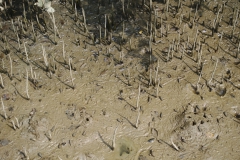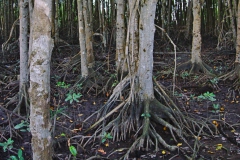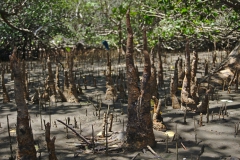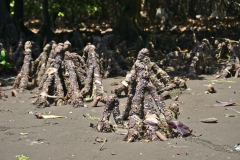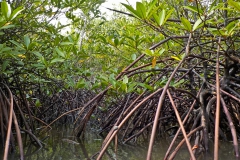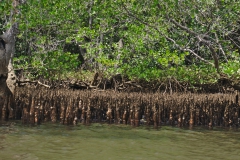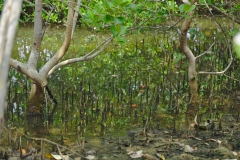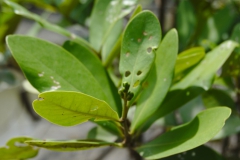What are mangroves?
Mangroves are forests along tropical and subtropical coasts – where the land meets the ocean. They consist of trees, shrubs, palms and ground ferns. Together, they form a unique ecosystem. A special feature of mangrove trees is their highly developed root system by which they stick to the soft ground. It will be differentiated between: prop roots, knee roots, pencil roots, cone roots and buttress roots. The term ‘mangrove’ describes both the ecosystem as a whole, as well as the plant species that it comprises.
Where do mangroves grow?
Mangrove forests occur in 118 countries, on both sides of the equator (Figure 1). They occupy around 0.5% of the world’s coastal area (Alongi, 2014) and account for 0.7% of the tropical forest area (Giri et al., 2011). The Indo-West Pacific region holds the largest and species-richest mangrove forests. Asia has the world’s largest mangrove area with 38.7%, followed by Latin America and Caribbean with 20.3%, Africa with 20.0%, Oceania with 11.9%, North America with 8.4% and European overseas territories with 0.7% (Bunting et al., 2018). Mangroves need water temperatures of at least 20 ° C, which is why they are missing in areas of cold ocean currents. They are among the halophytes, which are adapted to live in a saline environment. They grow in muddy, oxygen-poor soils and are subject to tides and high salt fluctuations. They grow in coastal areas within the intertidal zone – river deltas, estuaries and coastal lagoons are therefore particularly suitable habitats.

Physiology
The mangrove habitat is harsh – with muddy, low-oxygen soil, tidal changes and high salinity fluctuations. Different physiological and morphological adjustments allow them to live here. The most striking are the different forms of aerial roots. The above-ground root organs ensure that the plant is supplied with oxygen in the oxygen-poor soil and during the flood. So-called lenticels – fine pores – are used for gas exchange. Mangroves are among the halophytes – plants that grow in the saline environment. However, the species differ in their tolerance. In order to survive here, they have various mechanisms to regulate salt concentrations. Some species actively excrete the salt via salt glands, others accumulate the salt in older leaves, so it can be shed with the leaves. Salt absorption on the roots can also be restricted by ultrafiltration (Hogarth, 2015).
Reproduction
The flowers of the mangrove trees are pollinated by insects (including bees, moths, butterflies), bats, birds and by wind. After pollination, the seeds germinate on the parent tree (vivipary / cryptovivipary). The diaspore (dispersal unit) composed of a mature seed that will be released. The seedling floats on the water until it roots in a suitable place (Hogarth, 2015).
Why should we care about mangrove forests?
Mangrove forests are efficient CO2 sinks and contribute to climate change mitigation (keyword: ‘blue carbon’). They also provide habitat for a variety of animals, serve as coastal protection, improve water quality and maintain livelihood for many people.
Coastal Blue Carbon
The term ‘coastal blue carbon’ refers to the carbon captured by coastal ecosystems. These include salt marshes, seagrass beds and mangrove forests. Mangroves store the greenhouse gas carbon dioxide (CO2) in their biomass, but especially in the soil and sediment in which they root. Mangroves remain among the most carbon-rich forest environments. Due to deforestation the CO2 will be released again into the atmosphere.
UN Sustainable Development Goals: Biodiversity conservation and human development go hand in hand!
The world forest ecosystems are under pressure, especially in the global south – large-scale deforestation occurs for aquaculture areas, palm oil and rice plantations. European and North America markets are primarily served. The short-term profit is generated at the expense of long-term destruction of natural ecosystems.
In 2015, the Sustainable Development Goals were agreed upon by the United Nations. The 17 individual goals call for measures to improve people’s living conditions and protect ecosystems and climate.
The loss of mangrove forests has a direct impact on the climate, biodiversity and social stability:
- Climate change is impacting the world and more and more people are affected by sea-level rise, floods and droughts. Especially in the countries of the global south, natural disasters and extreme weather events occur more frequently and with increasing intensity. In particular, the ones to suffer are the already poor and marginalized in developing countries, whose resilience and adaption capacities are limited. Climate change affects us all – so ecosystems which capture and hold carbon need to be protected.
- Mangroves help maintaining healthy oceans. They are spawning and nursery ground for a variety of fish species and improve water quality of coastal regions. The destruction of mangrove forests will affect us all, no matter in which part of the world we live.
- More than 700 million people live in extreme poverty today (BMZ). Growing inequality increases political and social tensions and leads to instability and conflicts. A world without poverty and hunger is the basis for health, education, equality and social development. Our global well-being is interconnected.
